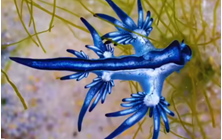

1st September 2025 (15 Topics)
Context:
Beaches in Spain were temporarily closed after the rare and venomous marine organism Blue Dragon (Glaucus atlanticus) appeared in coastal waters.
What are Blue Dragons?
- Scientific name:Glaucus atlanticus
- A type of nudibranch (sea slug).
- Small (about 3–4 cm long) but capable of delivering venom stronger than jellyfish they consume.

Habitat & Distribution
- Found in warm tropical and subtropical waters: Pacific, Atlantic, and Indian Oceans.
- Rarely seen in the Mediterranean Sea, but recent warming and climate anomalies may explain their arrival.
Feeding &Defence Mechanism
- Feed on Portuguese man o’ war and other siphonophores.
- Store stinging cells (nematocysts) from prey in their tissues and use them for defence.
- Venom can cause rashes, nausea, vomiting, and swelling in humans.
Reason for Arrival in Spain
- Climate change and warming of seas (Mediterranean Sea recently exceeded 28°C)
- Abnormal temperature anomalies and strong currents may have transported them.
Ecological Significance
- Indicator of marine ecosystem shifts due to rising temperatures and oceanic circulation changes.
- Show how warming seas are altering marine biodiversity distribution.
More Articles


